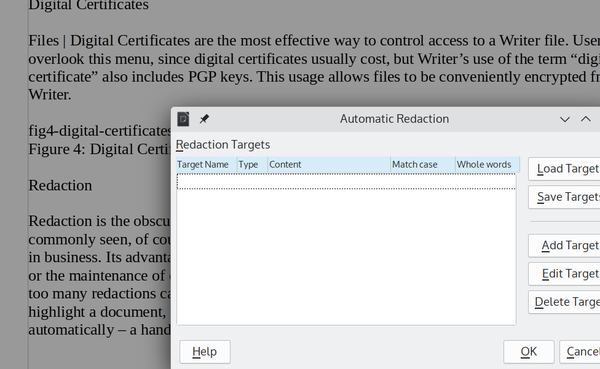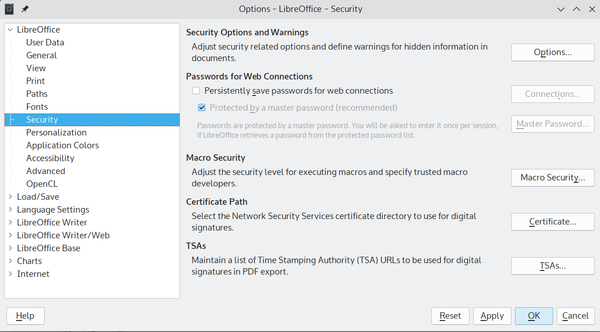Privacy and Security Tools in LibreOffice Writer
Redaction
Redaction is the obscuring of text that should not be read by those without full security clearance. Redaction is most commonly seen, of course, in de-classified government or legal documents, but it is also used sometimes in business. Its advantage is that it doesn’t require the creation of an additional version of a document or the maintenance of one. Its disadvantages are that readers can see that something is obscured and too many redactions can destroy credibility. In Writer, Tools | Redact uses LibreOffice Draw to highlight a document, while Tools | Automatic Redaction (Figure 5) sets up a list of texts and contents to redact automatically – a handy tool, but one that obviously requires careful setup and organization.
Tools | Options | LibreOffice | Security
This window (Figure 6) contains an assortment of security features, mostly to do with security whenever Writer is used:
- Warnings that a document contains hidden information, and when they should be given
- Passwords for browser connections
- Who can use and write macros
- The path to use for digital signatures
- Time Stamping Authority (TSA) links to use for digital signatures when exporting to PDF format.
Hidden and Forthcoming
To explore the privacy and security features of LibreOffice Writer is to dive into its more obscure and less-organized features. The majority of users, it can probably be said, are unaware of such features. However, whether you are concerned with internal or external privacy and security – which these days may include unauthorized AI training – there is a growing need for such features and for knowledge of their limitations.
In the past, LibreOffice menus have been rearranged and expanded several times. It’s possible that in some future release privacy and security feature will be given their own menu. It’s also possible that other features may appear among LibreOffice extensions. But there is no need to wait for future developments. If you look carefully, many features are already available.
« Previous 1 2
Buy Linux Magazine
Subscribe to our Linux Newsletters
Find Linux and Open Source Jobs
Subscribe to our ADMIN Newsletters
Support Our Work
Linux Magazine content is made possible with support from readers like you. Please consider contributing when you’ve found an article to be beneficial.

News
-
Parrot OS Switches to KDE Plasma Desktop
Yet another distro is making the move to the KDE Plasma desktop.
-
TUXEDO Announces Gemini 17
TUXEDO Computers has released the fourth generation of its Gemini laptop with plenty of updates.
-
Two New Distros Adopt Enlightenment
MX Moksha and AV Linux 25 join ranks with Bodhi Linux and embrace the Enlightenment desktop.
-
Solus Linux 4.8 Removes Python 2
Solus Linux 4.8 has been released with the latest Linux kernel, updated desktops, and a key removal.
-
Zorin OS 18 Hits over a Million Downloads
If you doubt Linux isn't gaining popularity, you only have to look at Zorin OS's download numbers.
-
TUXEDO Computers Scraps Snapdragon X1E-Based Laptop
Due to issues with a Snapdragon CPU, TUXEDO Computers has cancelled its plans to release a laptop based on this elite hardware.
-
Debian Unleashes Debian Libre Live
Debian Libre Live keeps your machine free of proprietary software.
-
Valve Announces Pending Release of Steam Machine
Shout it to the heavens: Steam Machine, powered by Linux, is set to arrive in 2026.
-
Happy Birthday, ADMIN Magazine!
ADMIN is celebrating its 15th anniversary with issue #90.
-
Another Linux Malware Discovered
Russian hackers use Hyper-V to hide malware within Linux virtual machines.



